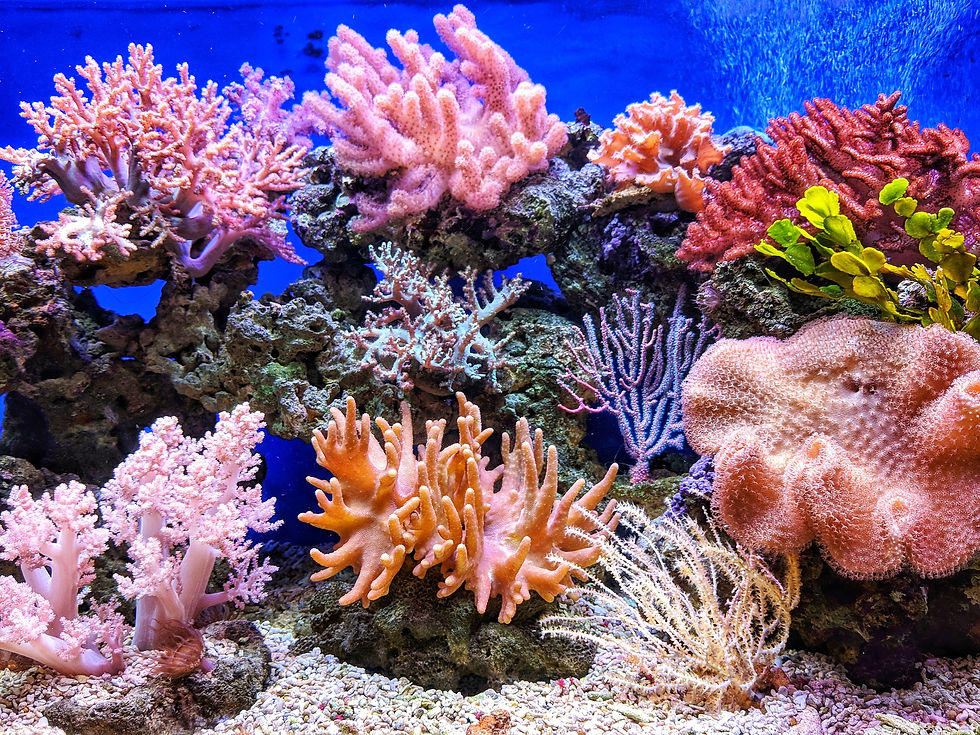The Fashion Industry and Ocean Pollution
- Lauren Dawson

- Jun 5, 2021
- 4 min read
Updated: Aug 16, 2021
Our oceans and marine life face a serious threat from global warming and pollution. National Geographic express that “More than 80% of marine pollution comes from land-based activities.”
Unfortunately, the production, transportation, and disposal of fashion is a factor which contributes to this figure. The fashion industry and its involvement in ocean pollution is a serious matter and we must raise awareness.
Whilst fashion is on its way to becoming more circular, it is still largely unsustainable. Morgan McFall-Johnsen (from Insider magazine) reported that “The fashion industry is responsible for 20% of all industrial water pollution” on a worldwide scale. This raises one major question – are we out of our depth?
How is the current fashion industry damaging to our oceans?
Whilst the fashion industry utilises recyclable plastics, they are largely non-biodegradable. Through washing clothes, 500,000 tons of microfibres are released into our oceans each year. This is the equivalent of 50 billion plastic bottles.
Furthermore, China Dialogue Ocean express that “Microplastics look similar to plankton, too, which is food for hundreds of species at the base of the food chain.” Micro plastics are toxic for the marine life who consume them and can cause death.
The production, transportation and disposal of clothes is worldwide. Unfortunately, the industry’s factory procedures and modes of transport and disposal is responsible for 10% of humanity’s carbon emissions.
As levels of Carbon Dioxide rise, the oceans absorb much of it. According the EPA, this consequently causes the water to become more acidic, and increased “Acidity will make it harder for corals to build skeletons and for shellfish to build the shells they need for protection.”
Textile dyeing is key to ensuring that fashion conforms to seasonal colours. However, textile dyes are The world’s second-largest polluter of water. Any water leftover from the dyeing process is often dumped into ditches, streams, or rivers. This is of course harmful for marine life as textile dyes usually contain acids.
“Water and air, the two essential fluids on which all life depends, have become global garbage cans.” Jacques Cousteau
How to become an advocate of change
Leading the way and being active is foundational to influencing change. Unfortunately, we can’t initiate instant change within the fashion industry, however, we can make our own educated choices.
Don’t send clothes to landfill. Although it may be tempting to put your old garments into bin bags…don’t do it. Drop them off at your local recycling points or take them to a charity shop. The landfill disposal of clothes really does raise those CO2 levels.
Put your washing into a special bag – Friends of the Earth advise us all to invest in a Guppy bag. This will help to collect some of the microfibres that our clothes shed in the wash. Consequently, less of them will end up in our oceans.
Invest in clothes made from biodegradable materials/textiles. Cotton is biodegradable, especially if your clothes are 100% cotton. The H&M Conscious range utilises organic cotton in many of its clothes.
Spread the word. Log in to your socials and give your voice a platform! While it may feel daunting at first, your voice could influence others to be advocates of change. You could help to educate them on the current threat that fashion poses upon our oceans.
Don’t neglect the cause – change always needs a voice behind it. Therefore, it is so important to keep using that voice. Keep encouraging fashion corporations to invest in and search for ocean-friendly and reusable materials. As well as encouraging them to seek both greener production and methods of disposal. The fashion industry must accept and compensate for its role in ocean pollution.
“We know that when we protect our oceans we’re protecting our future.” Bill Clinton
The major question surrounding the fashion industry and ocean pollution
Future predictions regarding ocean pollution and carbon emissions are horrifying. In 2020, The Ocean Cleanup estimated that between 24 and 35 million metric tonnes (Mt) of plastic waste was entering our aquatic environment on a yearly basis. Whereas in 2030, the non-profit organisation have predicted that there will be as much as 53 million Mt leaking into rivers, lakes, and oceans.
The Ellen MacArthur Foundation also estimate that unless significant change takes place, the fashion industry will use up a quarter of the world’s carbon budget by 2050.
So… are we are out of our depth? The answer is yes. Future predictions show that based on the way that the fashion industry currently operates, we are on route to submerge ourselves into an even deeper climate crisis. Sea levels will rise further, marine life will continue to die, and we will be held responsible.
As consumers of fashion, we must act responsibly.
It is important that we make smart decisions when shopping, help contribute towards the fashion industry becoming more circular, and use our voices for the greater good of the oceans and our planet.
If you wish to educate yourself further upon how some areas of the fashion industry are working to become more sustainable for our oceans and the planet, click here.



Comments